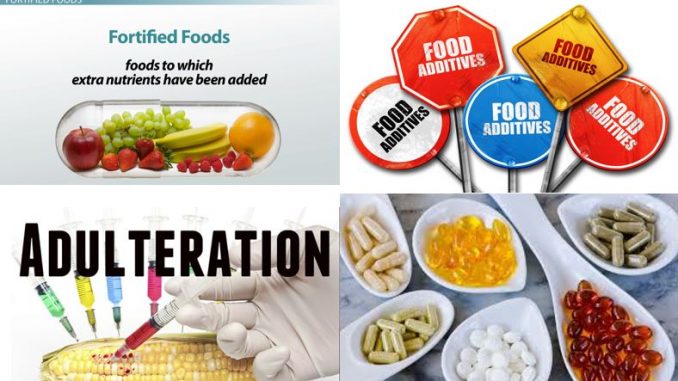
Table of Contents
Food fortification:
- Food fortification is also known as the food enrichment.
- Food fortification refers to the addition of nutrient/s to the food to increase the nutritional quality.
- Food fortification is one of the strategies to fight malnutrition.
- Example of commonly fortified foods include iodine in salt; iron in wheat and maize flours; vitamin A edible oils etc.
- Food fortification is usually done in staple foods.
- Foods fortified with iron will likely have the highest impact on anemia, although foods fortified with other nutrients, such as vitamin A and folic acid, may also be important.
Food supplementation:
- Food supplementation refers to supplementing/providing concentrated sources of nutrients (i.e. mineral and vitamins) or other substances with a nutritional or physiological effect that are marketed in “dose” form (e.g. pills, tablets, capsules, liquids in measured doses).
- Food supplementation are concentrated source that are marketed in dose form.
- Food supplementation are intended to correct nutritional deficiencies.
- The purpose of food supplementation is to supplement the normal diet with concentrated sources of nutrients or other substances with a nutritional or physiological effect
- They are highly concentrated form of nutrient produced by pharmaceutical manufactures in the form of capsules, tablets, pills.
- Examples: Vitamin A supplementation, Iron supplementation to pregnant and lactating women etc.
Food adulteration:
- Food adulteration refers to the addition or mixture of unwanted materials to the food.
- It is the process of decrease in the food quality due to addition of the lower quality products or due to the extraction of the important ingredient/s.
- Food adulteration decreases the quality of the food and could possess the threat
- The adulteration process could be intentional or incidental.
- Incidental adulteration refers to the addition of the foreign particle due to ignorance, negligence or accidently
- Intentional adulteration refers to the purposeful addition of foreign particle for improving the appearance, weight, or to gain profits.
- Addition of synthetic milk in cow milk, mixing of saw dust with turmeric or spices, etc., are the common examples of food adulteration.
Food additives:
- Food additives are substances added to food to maintain safety, freshness, taste, texture or appearance of the food/s.
- The use of food additives ranges from very ancient times to the current day. However, the quantity of food additives at present day has increased while the quality of additives has decreased over the time period.
- Food additives include food coloring, flavor enhancer or preservatives.
- Monosodium Glutamate (MSG), salt, etc., are the examples of the food additives
- They are not necessarily harmful, if used in right quantity and only if necessary.
Differences between ‘Food fortification’ and ‘Food adulteration’:
| Food fortification | Food adulteration |
| “The process whereby nutrients are added to foods to maintain or improve the quality of the diet of a group, a community or a population.” WHO | Food adulteration is the process of decrease in the food quality due to addition of the lower quality products or due to the extraction of the important ingredient.
|
| It has positive effect on health | It has negative effect on health |
| It is supposed to increase or improve the nutritional status of the people | It is supposed to decrease or deteriorate the health and nutrition status of the people |
| Food fortification is done after fulfilling the certain standard criteria | Food adulteration is incidental or intentional. |
| It is legal and global standard guidelines are followed for fortification of different food for different group of people | It is illegal |
Differences between ‘Food adulteration’ and ‘Food additives’:
| Food adulteration | Food additives |
| Food adulteration is the process of decrease in the food quality due to addition of the lower quality products or due to the extraction of the important ingredient
|
Food additives are the non-nutritional substances added to food to maintain safety, freshness, taste, texture or appearance of the food.
|
| It usually possesses health risk | They may or may not possess heath risk |
| Adulteration lowers or degrades the quality of the food | Additives improve the general quality of the food |
| Adulteration is unethical activity and is not accepted in food processing | Additive is permissible and, in many cases, an essential step as well for maintaining the quality of food |
| The prime motive of adulteration is to earn profit | The prime motive is of food additive to preserve the food |
| Examples: Addition of saw powder, brick powder, chalk powdered, etc., to the species is adulteration | Example: Species have certain level of additives in the form of the color to enhance the look/appearance |
References and for More Information:
https://www.nutritionintl.org/what-we-do/by-programs/fortification/
https://www.wvi.org/cambodia/what-food-fortification
https://www.anses.fr/en/content/what-are-food-supplements
https://www.efsa.europa.eu/en/topics/topic/food-supplements
https://www.sciencedirect.com/topics/food-science/food-adulteration
https://www.omicsonline.org/scholarly/food-adulteration-journals-articles-ppts-list.php
https://foodsafetyhelpline.com/2014/08/food-adulteration/
https://www.betterhealth.vic.gov.au/health/ConditionsAndTreatments/food-additives
http://www.who.int/news-room/fact-sheets/detail/food-additives
https://www.coursehero.com/file/23533564/FOOD-FORTIFICATION-FOOD-ADULTERATION-FOOD-ADDETIVIES/